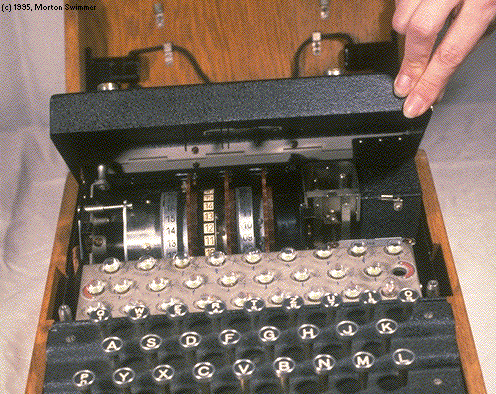Enigma
Enigma was a secret coding machine used by the Germans to encrypt messages during World War II.
In appearance the Enigma machine was no more than wooden box that contained a typewriter but it proved to be much more, as the Allies found out. It was made from numerous components including a light board, a plugboard, a keyboard, a reflector and finally a set of rotors.
The Germans had an operating manual that told the operators how to configure the Enigma machine every day. This was to reduce the risk of the encrypted messages being deciphered. They would daily change the plugboard connection, the starting positions of the rotors and the order they were in. The Germans under Hitler were extremely confident that nobody can break the code.
For the message to be deciphered the set up of the Enigma machine for the day is to be known. Otherwise one had to try million, million possible combinations.
The settings of the Enigma machine would be according to those printed in the manual for that particular day. The message would then be typed out in its existing form onto the keyboard. As the operator typed the message alternative letters would light up on the light board, the message was now in code. This would be written down to make the encrypted message. Finally by wireless the coded version of the message could now be sent in the form of Morse code. Thus preventing the Enemy from being able to understand what was being sent.
Fortunately for the British, Polish scientists had been quietly working behind the scenes and learned much about the Enigma in late 1930s. They pooled their information with the British when Poland was invaded by the Nazis. Two gentlemen, Alan Turing and Alfred Knox, were instrumental in the final breakdown of the Enigma. They created a gigantic machine called Colossus, which helped decipher complex intercepted Enigma messages. Colossus performed thousands of mathematical calculations at unheard-of-speed, at least for that time. The "computer" could read and check about 5,000 characters per second !
The British Army, Navy, Mathematicians and Scientists were all involved in this Code breaking process. British Commanders devised wild tricks : they would crash land a captured German plane into the English channel and then wait for the German Patrol boats to come for rescuing any survivors, whereupon they would capture the patrol boat and with it the code-book. This helped them know the enigma settings for that month and sometimes for the next month as well. The messages decrypted from the enigma were called Ultra and were kept a top secret, even if the information was not a valuble one (ex: weather forecase related) for fear of Germans coming to know that the Enigma code has been broken. It is said that even when they knew of possible attacks, the British soldiers weren't on alert fearing that this would lead to Germans getting suspicious.
This technique payed off for a while until the Germans came to know about it and in 1942, they promptly added a fifth rotor to the enigma machines. But it was too late for them. Though this increased the number of combinations and pushed the allies back to square one, the British had by now become experienced and they could still decipher many important information by using a combination of human guess work and the computers. Finally the allies were able to gain an upperhand in the battle of atlantic against the Germans. Though it would be an exaggeration to say that the Germans would have won the battle if the enigma codes had not been deciphered, it is believed that it could have easily taken another 4 to 5 years for the war to end.

















 Johann Bernoulli
Johann Bernoulli 
 Nicolaus II
Nicolaus II
 Johann II
Johann II
 Jacob II
Jacob II
